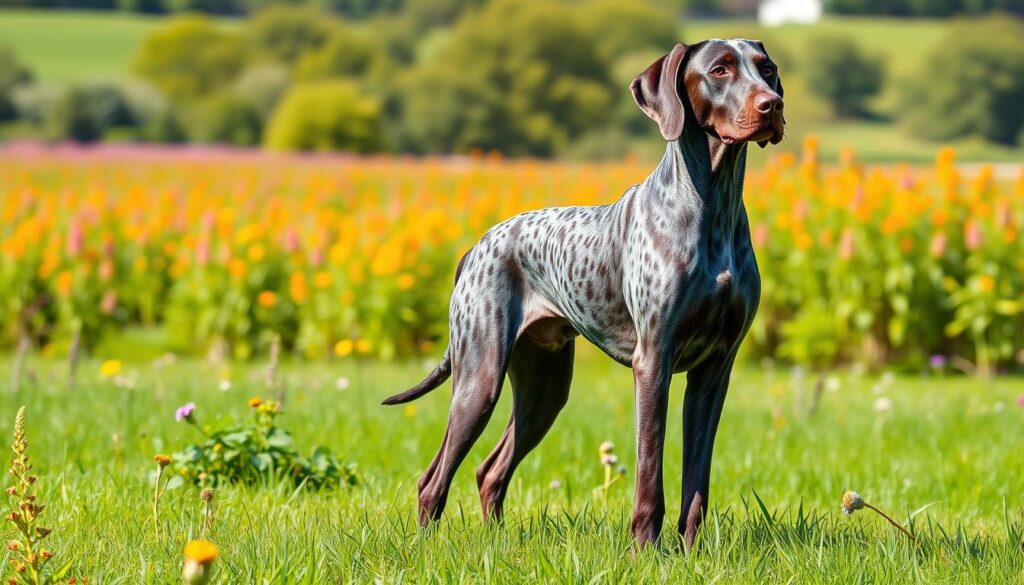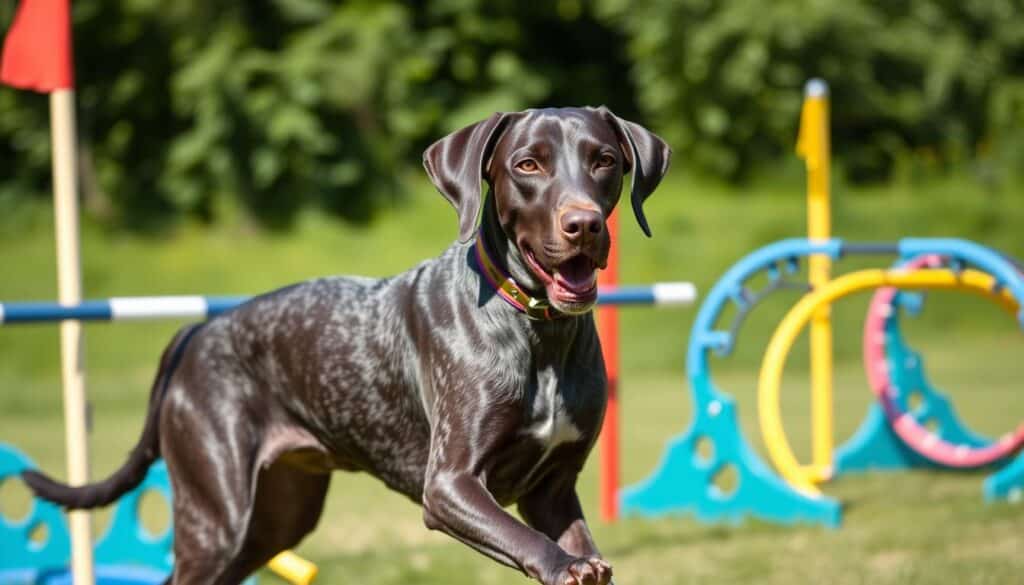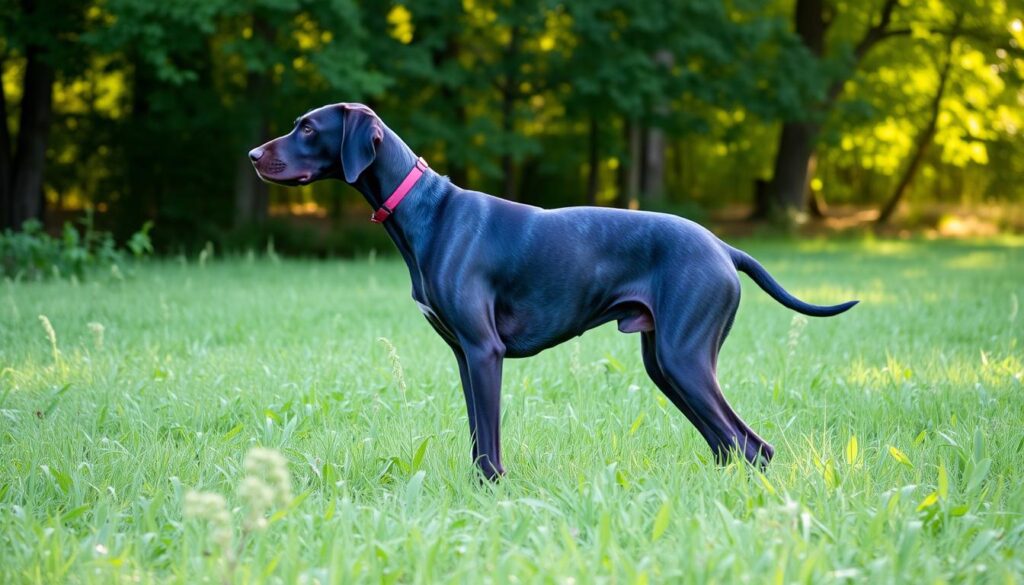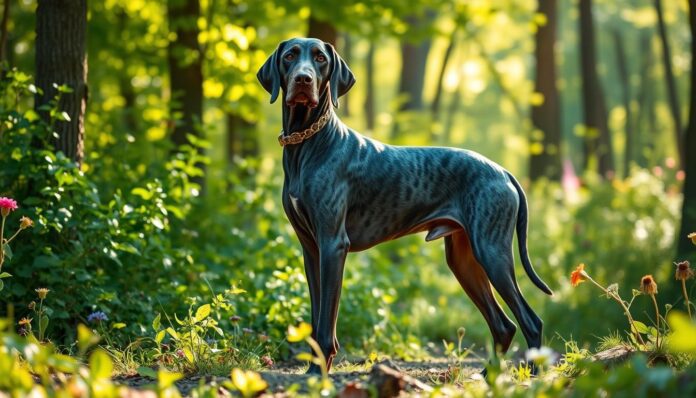The blue german shorthaired pointer is a unique and versatile breed. It’s known for its distinctive blue coat and exceptional hunting abilities. This breed has gained popularity in the United States for its intelligence, athleticism, and loyal nature.
With its rich history and breed recognition, the blue german shorthaired pointer is highly sought after. It’s cherished for its striking appearance and impressive skills in the field. Whether as a family pet or a trusted hunting partner, this breed is a perfect blend of beauty, intelligence, and loyalty.
Understanding the Blue German Shorthaired Pointer
The blue gsp breed is known for its striking coat and versatility. They are intelligent and friendly, making great companions and hunting partners.
Origin and History
The Blue German Shorthaired Pointer comes from Germany. It was bred to be good at both upland and water hunting. This made them adaptable to different terrains.
Breed Recognition
Even though many people love them, not all kennel clubs recognize the blue gsp breed. Clubs like the American Kennel Club (AKC) might not list the blue version. This can limit their ability to show in conformation shows.
The Blue Color Variation
The blue GSP’s coat is a special shade due to a dilute gene. It ranges from silvery grey to charcoal. This color also affects their eye color, making them stand out from standard German Shorthaired Pointers.
Physical Characteristics and Appearance
The Blue German Shorthaired Pointer has a strong and athletic build. This makes it a top-notch sporting dog. Its muscular body is perfect for agility and endurance, key for hunting.
Males are usually 22 to 25 inches tall, while females are a bit smaller, at 21 to 23 inches. Males weigh between 55 to 70 pounds, and females between 45 to 60 pounds.
Their head is broad with expressive eyes and long, floppy ears. These help them track scents better. Their deep chest and sturdy legs are great for running and swimming, making them versatile in the field.
Key physical features include:
- Strong, broad head with alert expression
- Long, floppy ears aiding in scent tracking
- Webbed feet for efficient swimming
- Sleek, dense blue coat suitable for various terrains
Their blue coat is not just for looks; it helps them blend in during hunts. Their size, strength, and unique markings make them great hunting companions and family pets.
| Gender | Height | Weight |
|---|---|---|
| Male | 22-25 inches | 55-70 pounds |
| Female | 21-23 inches | 45-60 pounds |
The Distinct Blue Coat Pattern and Genetics
The blue German Shorthaired Pointer has a unique coat that catches the eye. This color comes from special genes that make blue GSPs rare and sought after.

Color Inheritance Patterns
The blue color in a blue German Shorthaired Pointer comes from a dilution gene. This gene changes the liver or black coat to slate or gray. If both parents have this gene, their puppies are more likely to have the blue coat.
Coat Texture and Maintenance
The blue German Shorthaired Pointer has a dense, short coat. It needs regular grooming to stay shiny and prevent matting. Brushing once a week helps remove loose hair and spreads natural oils.
Also, occasional baths with mild dog shampoo keep the coat clean and bright.
Common Markings and Variations
Blue GSPs can have different markings and patterns. These include solid blue coats, blue roan patterns, and ticked markings. Each one adds to their camouflage and hunting skills.
| Coat Variation | Description |
|---|---|
| Solid Blue | A uniform slate or gray coat without any additional markings. |
| Blue Roan | A mix of blue and white hairs, creating a speckled appearance. |
| Ticked | Small flecks of color on a white background, improving camouflage. |
Yoy May Like : Black and Tan Coonhound: America’s Great Hunting Dog
Temperament and Personality Traits
The Blue German Shorthaired Pointer is known for its lively energy and friendly vibe. These dogs love to be active and need lots of things to do.

GSPs are very social and bond strongly with their families. They love to join in on daily activities and need lots of interaction to be happy.
When thinking about can gsp be aggressive, it’s key to know that aggression is rare in GSPs. They might be cautious around strangers, but with the right training and socialization, they can be well-balanced.
- High Energy: Needs 1-2 hours of intense exercise every day.
- Intelligent and Trainable: Does great in obedience and agility training.
- Friendly and Affectionate: Loves being around people and enjoys family time.
- Protective Nature: Alert and can guard their home without being aggressive.
Keeping them mentally and physically active is important to avoid bad behavior. If they don’t get enough activity, they might get destructive. But, their friendly and eager-to-please nature makes them great friends for active people and families.
Training and Intelligence Capabilities
The german shorthaired pointer is known for its remarkable intelligence and eagerness to learn. Early socialization and consistent training are key to nurturing a well-behaved pet.

Basic Obedience Training
Start training your german shorthaired pointer early using positive reinforcement techniques. Consistency and patience help in establishing fundamental commands such as sit, stay, and come.
Advanced Training Methods
- Incorporate agility courses to challenge their physical abilities.
- Teach advanced commands and tricks to keep their minds sharp.
- Engage in scent work or tracking exercises to utilize their natural hunting instincts.
Mental Stimulation Needs
Mental stimulation is essential for these intelligent dogs. Provide puzzle toys, interactive games, and regular training sessions to prevent boredom and promote mental well-being.
Hunting Abilities and Field Performance
The blue German Shorthaired Pointer is a top choice for hunting. It’s known for its natural hunting skills and versatility. Hunters love these dogs for tracking, pointing, and retrieving game with great efficiency.

This breed has a strong build and a keen sense of smell. It excels in different hunting places, from dense forests to open wetlands. Their blue coat helps them blend in, making them effective hunters anywhere.
- Natural Instincts: Innate ability to locate and track game.
- Versatility: Proficient in both upland and waterfowl hunting.
- Endurance: Capable of long hunting sessions without fatigue.
- Intelligence: Quick learners, easily trained for specific hunting tasks.
The blue hunting dog’s agility and strength are key to its field success. Their friendly and cooperative nature also makes them great companions for hunters. This enhances the hunting experience.
| Characteristic | Description |
|---|---|
| Instincts | Highly developed natural hunting abilities |
| Versatility | Effective in various hunting scenarios |
| Physical Traits | Agile, strong, and endurance-driven |
| Training | Easily trained for specialized hunting tasks |
Health Considerations and Lifespan
The blue GSP breed is generally healthy, living between 10 to 14 years. Owners should know about common health issues to keep their pets happy and healthy.
Common Health Issues
Blue GSPs often face hip dysplasia, which affects their joints. They can also get bloat, a serious condition. Heart problems like subaortic stenosis are common too.
They might also have skin issues like allergies and entropion, where their eyelids roll inward. Cancer is a big concern for older dogs, including blue GSPs.
Preventative Care
Keeping a blue GSP healthy means regular vet visits. A good diet and exercise are key to prevent obesity and joint problems. Regular grooming helps spot any health issues early.
Genetic Screening
Genetic screening is vital for the blue GSP breed’s health. It helps find inherited conditions like subaortic stenosis and hip dysplasia. This way, breeders can make better choices, ensuring healthier dogs.
| Health Issue | Description |
|---|---|
| Hip Dysplasia | A genetic condition affecting the joints, leading to pain and mobility issues. |
| Gastric Dilatation-Volvulus (Bloat) | A life-threatening condition where the stomach twists, requiring immediate medical attention. |
| Subaortic Stenosis | A heart condition that can cause irregular heartbeats and reduce lifespan. |
| Entropion | An eye condition causing the eyelids to roll inward, leading to discomfort and vision problems. |
| Cancer | Leading cause of death in older blue GSPs, requiring regular screenings. |
Exercise Requirements and Daily Activity
Blue German Shorthaired Pointers are full of energy and love to stay active. It’s key to understand their needs to keep them happy and healthy.
Physical Exercise Needs
These dogs need at least two hours of intense exercise every day. They should get activities that test their endurance and agility. Without enough exercise, they might get restless and exhibit bad behaviors.
Recommended Activities
Here are some activities to meet their physical and mental needs:
- Agility Training: Boosts their coordination and keeps their minds active.
- Swimming: A gentle exercise that’s easy on their joints.
- Fetch and Retrieval Games: Uses their natural hunting skills.
- Hiking: Offers physical activity and mental stimulation.
Regular exercise not only fulfills their needs but also strengthens the bond between dog and owner.
Family Life and Social Behavior
The Blue German Shorthaired Pointer loves being part of an active family. It has lots of energy and is great for families who love the outdoors. They enjoy activities like hiking, running, and playing fetch.
Children get along well with these dogs because they are friendly and patient. They play nicely with kids, building strong bonds of trust and love. These dogs are also loyal and protective, making the family feel safe.
German Shorthaired Pointers are very adaptable. They fit well in big homes or small apartments. Their smart nature makes learning easy, so they pick up household rules quickly.
Having other pets is okay too. They get along well with other animals, making the home peaceful. Their loving nature makes them a big part of the family, bringing joy and companionship.
In short, is a german shorthaired pointer a good family dog is a big yes. They have lots of energy, are smart, and loving. This makes them perfect for many different family types.
Conclusion: Is the Blue German Shorthaired Pointer Right for You?
The blue German Shorthaired Pointer is a versatile and loyal friend. They weigh between 45-70 pounds and love active homes. Their intelligence makes training fun, but they shed moderately, needing regular grooming.
They need lots of exercise and mental play. If you’re up for it, they’ll bring energy and love to your family. They live about 10-12 years, filled with fun and companionship.
Health is key, as they might get hip dysplasia or heart issues. Regular vet visits and care are vital for their well-being. They’re high-energy, so they need lots of physical activities.
Having a blue German Shorthaired Pointer can bring lots of joy. If you’re active and ready to train and exercise them, they’re a great choice. They’ll be a loyal and energetic friend in your home.
FAQ
What makes the Blue German Shorthaired Pointer unique compared to other German Shorthaired Pointers?
The Blue German Shorthaired Pointer is special because of its blue coat. This rare color makes them stand out. Their blue coat, athletic build, and hunting skills make them beautiful and effective.
Are Blue German Shorthaired Pointers good family dogs?
Yes, Blue German Shorthaired Pointers are great with families. They are loving, loyal, and love to play. They are perfect for active homes with kids who love the outdoors.
Can Blue German Shorthaired Pointers be aggressive?
No, Blue GSPs are usually friendly. They get along with other pets and people if they are socialized right. Training and socialization are key to keeping them friendly.
What are the exercise requirements for a Blue German Shorthaired Pointer?
A: Blue German Shorthaired Pointers need lots of exercise. They love to run, hike, and play fetch. They also need mental games to keep them happy and prevent bad behavior.
How do Blue German Shorthaired Pointers perform as hunting dogs?
As blue hunting dogs, Blue GSPs are excellent hunters. They have a great sense of smell and can track game in different places. Their blue coat doesn’t stop them from being great hunters.
What are the common health issues in Blue German Shorthaired Pointers?
A: Blue GSPs are usually healthy, but they can get sick like any dog. They might get hip or elbow problems, or eye issues. Regular vet visits and tests can help keep them healthy.
How should I maintain the blue coat of my German Shorthaired Pointer?
To keep your Blue German Shorthaired Pointer‘s coat looking good, groom them often. Brushing a few times a week keeps their coat clean and their color bright. Baths and good dog shampoo also help.
Are Blue German Shorthaired Pointers intelligent and easy to train?
Yes, Blue GSPs are very smart and easy to teach. They learn fast and enjoy pleasing their owners. Training them well and early is important for their behavior.
What is the lifespan of a Blue German Shorthaired Pointer?
A: Blue German Shorthaired Pointers live about 12 to 14 years. Eating well, exercising, and vet care help them live long and healthy lives. Good breeding and health checks are also important.
Do Blue German Shorthaired Pointers get along with other pets?
Yes, Blue German Shorthaired Pointers are friendly with other pets. They are great with dogs and other animals if they are introduced and socialized early. They make a happy home for everyone.


